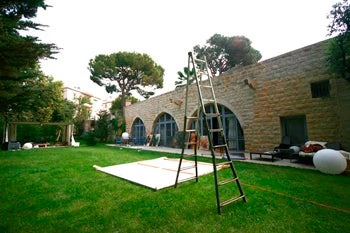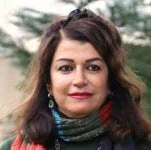
After the situation in Syria deteriorated, around October 2011, thousands of Syrians fled to Lebanon, among them many young emerging artists. With the difficult conditions and emotional trauma, artists had to take jobs in construction and in restaurants instead of creating art. Given the situation and my belief in the importance of art in hard times, the idea of an artists’ residence in the town of Aley, or the Art Residence in Aley (ARA), arose.
I had stumbled across abandoned horse stables in Aley, a word which means “heights” in Arabic, in the mountains outside Beirut. The 200 year-old stables were destroyed during Lebanon’s civil war (1975-1990). I was especially touched by a fruitless walnut tree standing sadly in the grounds. To me, the stables and walnut tree symbolized the greater conflict in Syria. My country is ruined but it still possesses an inner beauty that I cannot ignore. With the right amount of love and energy, I knew I could revive the structure into something productive and new. And, in turn, revival is what I hope Syrian art will do for its country.
As a civil engineer, I saw the opportunity to transform the stables into something beautiful. In my hometown, Damascus, I had made a career out of my artistic eye. After my masters in structural engineering, I worked as a professor at the Intermediate Engineering Institute of Damascus University. I also worked in design and architecture. The “Light and Art House” I designed in Yafour, a suburb of Damascus, was the highlight of my career – I still miss it to this day.
Art, however, is far more than my career; it is my passion. I had spent years in the studios and ateliers of Damascus, breathing in the creative atmosphere and befriending countless artists. These artists and their strong spirits helped me survive a very difficult time in my life.
Each month in Aley, I provide full-board accommodation, work materials, and a stipend for two young artists. The project offers Syrian refugee artists a feeling of security, as well as space for freedom of expression and inspiration. In this environment, artists thrive and grow tremendously in their work. Many forms of art have been showcased at ARA: painting, sculpture, performances, video art, etching, photography, theatre, and music.
In this way, the artist’s residence acts like a cultural safety net: We are rapidly losing Syria’s history and beauty. This is my attempt to preserve Syrian culture as the country spills over into Lebanon.
The project has evolved into a dynamic space for expression and creativity. Now it is a collective community of artists, as well as a platform to launch emerging artists into the Lebanese art scene and beyond. So, not only does ARA capture Syrian talent, but the project also unleashes Syrian art into the world. Both Lebanese and international art associations have readily embraced our project. The art created at ARA has been new and transformative, especially in terms of the Lebanese art scene.
Most importantly, ARA is a tool that can remold misconceptions about Syria. We are not violent extremists; rather we are a resilient and beautiful people even in the face of war. ARA is both a catalyst to its artists’ futures and to foreign understanding of Syria.
Raghad Mardini is a Syrian civil engineer who founded the Art Residence in Aley, Lebanon. It held its first exhibition in October 2012. http://artresidencealey.com
Yafour Light and Art House in Damascus: www.lightart-house.com
As a civil engineer, I saw the opportunity to transform the stables into something beautiful. In my hometown, Damascus, I had made a career out of my artistic eye. After my masters in structural engineering, I worked as a professor at the Intermediate Engineering Institute of Damascus University. I also worked in design and architecture. The “Light and Art House” I designed in Yafour, a suburb of Damascus, was the highlight of my career – I still miss it to this day.
Art, however, is far more than my career; it is my passion. I had spent years in the studios and ateliers of Damascus, breathing in the creative atmosphere and befriending countless artists. These artists and their strong spirits helped me survive a very difficult time in my life.
Each month in Aley, I provide full-board accommodation, work materials, and a stipend for two young artists. The project offers Syrian refugee artists a feeling of security, as well as space for freedom of expression and inspiration. In this environment, artists thrive and grow tremendously in their work. Many forms of art have been showcased at ARA: painting, sculpture, performances, video art, etching, photography, theatre, and music.
In this way, the artist’s residence acts like a cultural safety net: We are rapidly losing Syria’s history and beauty. This is my attempt to preserve Syrian culture as the country spills over into Lebanon.
The project has evolved into a dynamic space for expression and creativity. Now it is a collective community of artists, as well as a platform to launch emerging artists into the Lebanese art scene and beyond. So, not only does ARA capture Syrian talent, but the project also unleashes Syrian art into the world. Both Lebanese and international art associations have readily embraced our project. The art created at ARA has been new and transformative, especially in terms of the Lebanese art scene.
Most importantly, ARA is a tool that can remold misconceptions about Syria. We are not violent extremists; rather we are a resilient and beautiful people even in the face of war. ARA is both a catalyst to its artists’ futures and to foreign understanding of Syria.
Raghad Mardini is a Syrian civil engineer who founded the Art Residence in Aley, Lebanon. It held its first exhibition in October 2012. http://artresidencealey.com
Yafour Light and Art House in Damascus: www.lightart-house.com


Join the Conversation